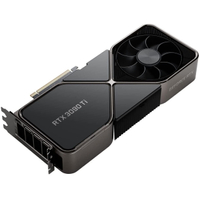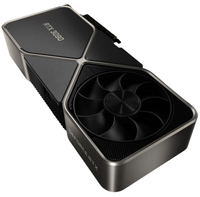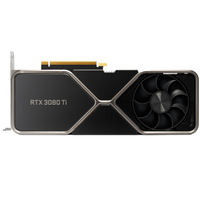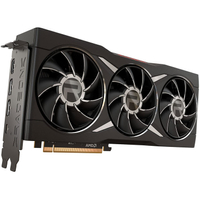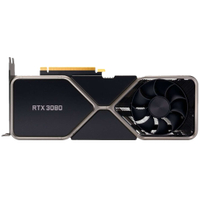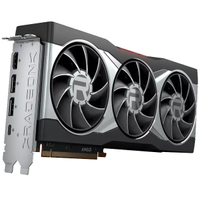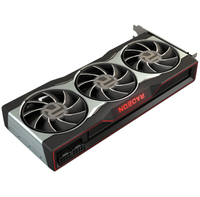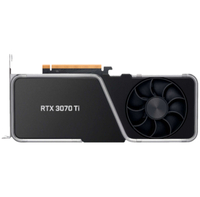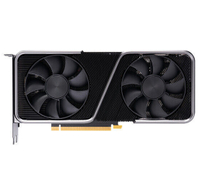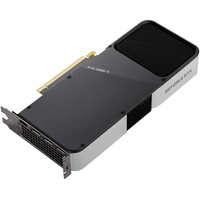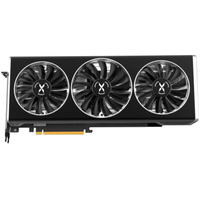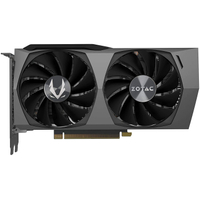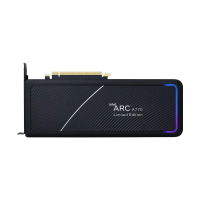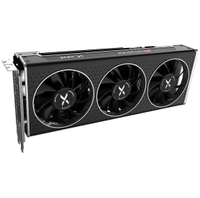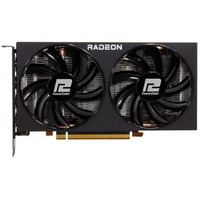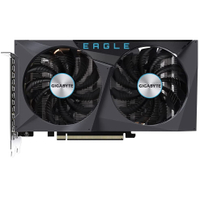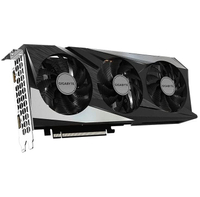Best graphics cards: the GPUs I recommend for every budget
Our picks of the most powerful gaming GPUs and the ones that provide the best bang for your buck.
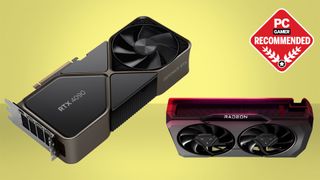
The best graphics card is objectively Nvidia's RTX 4090. Subjectively, however, you're going to want to weigh up the pros and cons of spending $1,600 or more on a single GPU. It's not for everyone. That's why we've tested every new GPU made by AMD, Intel, and Nvidia to find the best card across multiple price points.
For the high-end gamer, the best $600 to $800 graphics card is the RTX 4070 Ti Super and just below that price point, the best $500 to $600 graphics card is the RTX 4070 Super. They're both fast and feature-rich, with superior ray tracing performance, upscaling, and frame generation than the competition, though they are quite pricey.
While AMD's best graphics card is the top-end RX 7900 XTX, its lower-spec models are great value for money. The best $350 to $500 graphics card is the RX 7800 XT and in the $250 to $350 range, the RX 6700 XT is by far the best card you can get. When it comes to saving as much as you can but still getting good performance, the best budget graphics card is AMD's Radeon RX 7600.
It's worth noting that the start of the next generation of GPUs has already begun, with Intel launching its Battlemage-powered B-series of Arc graphics cards. And it won't long before we'll see Nvidia's Blackwell 50-series GPUs and AMD's RDNA 4 GPUs too. That being said, it'll be a little while before most of these hit the shelves, and everything in the top spots in this guide remains a great pick for your next graphics card purchase both now and in the future. Below I've listed the most relevant GPUs you can buy today, all in order of gaming performance, so you can make the most informed choice.

Jacob has loads of experience with the latest and greatest graphics cards, reviewing many generations of Nvidia and AMD GPU over the years. He's au fait with the latest architectures, and makes sure to rotate through the latest cards from all three major manufacturers to get first-hand experience of what they're like to game with. Not just of their performance, but also which offer the most useful features and have the most reliable drivers.
The quick list
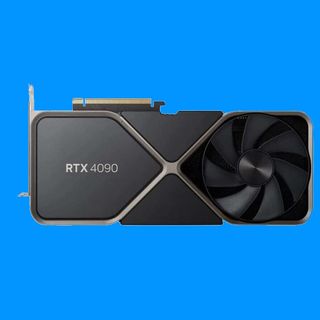
The best overall GPU
The RTX 4090 is where it's at. This is the graphics card that truly represents a genuinely next-generation experience, but it's also very expensive. However, if you're looking for the best graphics card in terms of performance right now, look no further.
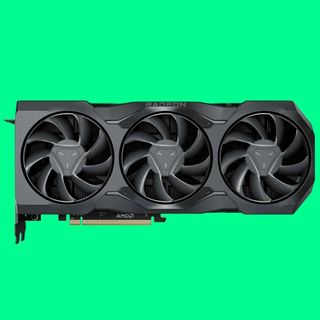
The best AMD GPU
AMD has managed a supremely impressive feat with the RX 7900 XTX: it has managed to make the first generation of chiplet GPU actually work, and work at the high end. Sometimes it beats the RTX 4080, and for a good chunk less cash, too.
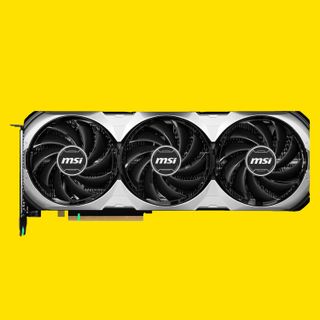
The best $600 - $800 GPU
While we had the odd issue with our MSI review unit, the RTX 4070 Ti Super is fantastic at high-refresh 1080p and 1440p gaming—and thanks to that 16 GB of VRAM and a little bit of help from DLSS 3, it makes for a great 4K card, too.
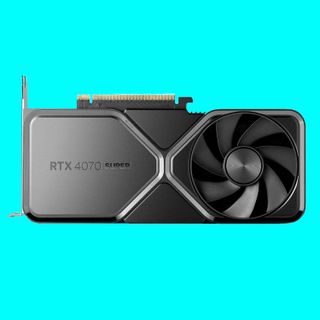
The best $500 - $600 GPU
Nvidia's refreshed mid-range Ada GPU has a significant core count boost, which makes it superior to the original RTX 4070 for the same money. It's faster than both the cheaper 40-series card and the AMD RX 7900 GRE, though they remain tempting alternatives.
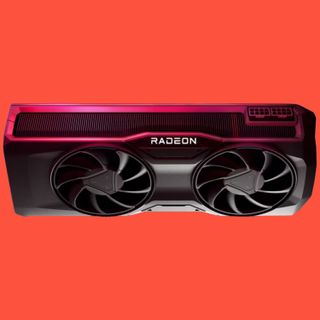
The best $350 - $500 GPU
A very good graphics card for non ray-traced gaming and 1440p performance, and the best performing sub-$500 card. But with a multi-chip GPU that isn't moving the game forward, all it really has over its last-gen stablemate is that lower price.
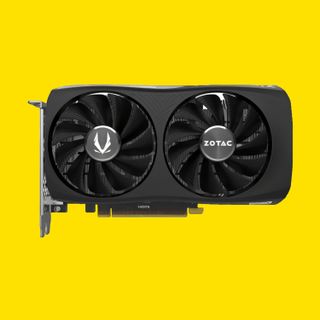
The best $250 - $350 GPU
The RTX 4060 could really do with more performance or a lower price tag, but right now, it's the best GPU in this sector that you can easily buy. If you're upgrading from a much older graphics card, you'll appreciate its DLSS feature set.
⬇️ Click to load more of the best graphics cards⬇️

The best budget GPU
The AMD Radeon RX 7600 offers good 1080p performance, and it represents excellent value for money for long-suffering gamers. However, it's not the most exciting card, and it faces tough competition in the form of the more expensive RTX 4060.
Recent updates
Updated December 6, 2024 to add a note about the launch of the Intel B-series of Arc graphics cards and to change our recommendation in the $250-$350 sector from a Radeon RX 6700 XT to a GeForce RTX 4060. Stocks of the old RDNA 2 card have significantly dwindled so it can be hard to find one available new.
Nvidia GeForce RTX 4090
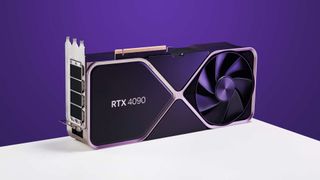
Specifications
Reasons to buy
Reasons to avoid
✅ You want the best: The RTX 4090 is simply the most powerful GPU you can buy for your gaming PC today. The silicon inside it is monstrously powerful, and along with DLSS 3 and Frame Generation, it provides a truly next-gen experience.
✅ You want to nail 4K gaming: This is the card that makes 4K gaming buttery smooth. That 24 GB frame buffer means you're not going to run out of VRAM any time soon.
✅ You're a creator as well as a gamer: Time is money if you do any sort of professional GPU work, and the RTX 4090 could start to pay for itself right away given its incredible rendering and compute power.
❌ You need to ask the price: It's fair to say that it's one of the best value Ada GPUs given its relative price-performance ratio, but it's still $1,600 at best. That's far cheaper than the RTX 3090 Ti was, and the RTX 3090 if you take inflation into account.
❌ You have a compact rig: This thing is BIG. Like, comically big. You'll struggle to fit it in some cases, so make sure you measure first.
🪛 The RTX 4090 is the true next-gen experience that we simply haven't seen from any of the other AMD or Nvidia cards from this new generation. And that almost makes it worth that exorbitant price tag.
The best graphics card right now is Nvidia's GeForce RTX 4090 and there's nothing subtle about this ultimate gaming performance monster. It's a hulking great lump of a pixel pusher, and while there are some extra curves added to what could otherwise look like a respin of the RTX 3090 shroud, it still has that novelty graphics card aesthetic.
It looks like some semi-satirical plastic model made up to skewer GPU makers for the ever-increasing size of their cards. But it's no model, and it's no moon, this is the vanguard for the entire RTX 40-series GPU generation, a complete beast of a gaming component that leaves all others in the dust.
On the one hand, it served as a hell of an introduction to the sort of extreme performance Ada can deliver when given a long leash, and on the other, made for a slightly tone-deaf release in light of a global economic crisis that made launching a graphics card for a small, very loaded minority of gamers feel a bit off.
But we can't ignore it for this guide to the best GPUs simply because, as it stands today, no alternative to the RTX 4090 can get anywhere close to its performance. It's unstoppable and will stay ahead of the pack given that AMD's highest-performance graphics card, the RX 7900 XTX, is more of an RTX 4080 competitor.
It's worth noting that a replacement appears to be on its way, which we're keeping track of here. That being said, the RTX 4090 is powerful enough that it's still very likely to stand head and shoulders above most of the next generation cards, too.
This is a vast GPU that packs in 170% more transistors than even the impossibly chonky GA102 chip that powered the RTX 3090 Ti. And, for the most part, it makes the previous flagship card of the Ampere generation look well off the pace. And that's even before you get into the equal mix of majesty and black magic that lies behind DLSS 3 and all its upscaling and Frame Generation trickery, boosting its performance further into the stratosphere.
Look, it's quick, okay. With everything turned on, and especially with DLSS 3 and Frame Generation joining the party, the RTX 4090 is monumentally faster than the RTX 3090 that came before it. The straight 3DMark Time Spy Extreme score is twice that of the biggest Ampere core, and before even ray tracing or DLSS come into it, the raw silicon offers twice the 4K frame rate in Cyberpunk 2077, too.
There's no denying it is an ultra-niche ultra-enthusiast card, and that almost makes the RTX 4090 little more than a reference point for most of us PC gamers. We're then left counting the days until Ada descends to the pricing realm of us mere mortals, which looks unlikely to happen until we see what the next generation of cards brings.
In itself, however, the RTX 4090 is an excellent graphics card and will satisfy the performance cravings of every person who could ever justify spending $1,600 on a new GPU. And it will deservedly sell to those who can afford it because there's no other GPU that can come even close to it right now.
Read our full Nvidia GeForce RTX 4090 review.
Nvidia GeForce RTX 4080 Super






Specifications
Reasons to buy
Reasons to avoid
✅ You can find an MSRP (or less) card: The price cut is the real strength of the Super variant, so you'll really want to find one at its $999 MSRP or less to get the maximum price/performance benefit.
✅ You want good 4K ray traced gaming performance: Ada is efficient and really good at dealing with the rigours of ray tracing. Add DLSS 3 and Frame Generation to the mix and the RTX 4080 Super excels at delivering solid 4K frame rates.
❌ Ray tracing means nothing to you: In pure rasterised gaming terms, the RX 7900 XTX from AMD can often outperform the RTX 4080 Super, and that makes it a very tempting option, especially if you can find one cheaper than the Nvidia card.
🪛 The RTX 4080 Super is a far more tempting prospect given its $200 price cut over the standard RTX 4080. That brings it to the same price as the AMD 7900 XTX and the balance of features and ray tracing performance brings us down on the side of Nvidia. Now the RTX 4090 is ludicrously expensive, it's fast become the top GPU you can buy for a somewhat reasonable price today.
Less is more, right? I mean, technically the RTX 4080 Super is actually more is less when you consider you're getting a full AD103 GPU for less cash. But it's the pricing change which is the real kicker, as it's the only tangible difference between this and the original RTX 4080.
Though it's not like you'd ever need to weigh up the differences between the RTX 4080 and the RTX 4080 Super; the older version has effectively been killed. The RTX 4080 Super sits at the top of the high-end (but not ultra-high-end) throne and remains as desirable a card today as it was when it first released.
So, it's all about weighing up how much of a difference that price cut has made to the positioning of the RTX 4080 Super. Let's be honest, with a $999 MSRP, it's still nobody's idea of cheap, and arguably should still be cheaper than what we're left with here.
But we can't get too bent out of shape over what might have been; this is about the product I have in front of me, and the RTX 4080 Super is the same super-powerful graphics card it was when its predecessor launched. It's a card which makes the once top GPU of the Ampere age look utterly laggardly—and incredibly inefficient—by comparison. At $999, it looks even better when put up against the $1,500 RTX 3090 of the previous gen.
The price cut and slight performance bump also now make it tougher for AMD's best RDNA 3 card by comparison, though it is still very tight. Our two original reference RX 7900 XTX cards were beset by thermal issues and performed very badly, but third-party cards, and subsequent driver improvements, resulted in a Radeon GPU that was generally priced below the $1,200 RTX 4080 but in pure raster terms often outperformed it.
With a much more competitive $999 MSRP, the RTX 4080 Super doesn't change the game in terms of comparative performance—on average 2% slower at 4K settings—but it does make it generally cheaper than the speedy third-party OC RX 7900 XTX cards. Combine that with the weight of DLSS 3 and Frame Generation support, and that just about swings it for the RTX 4080 Super.
But it is still a close-run thing, and I certainly wouldn't begrudge anyone picking the RX 7900 XTX over the latest GeForce GPU if they could find it for less.
However, after reportedly poor RTX 4080 sales—and worse press around its launch and pricing—the RTX 4080 Super does feel like a pretty successful relaunch. It's got a prettier shroud, and the same great performance but for a lower price.
The RTX 4080 Super is a serious bit of gaming hardware, and if you've got serious cash for a majorly fast GPU and want to take advantage of Nvidia's extra goodies, all without stretching to RTX 4090 prices, here's where you probably want to be.
Read our full Nvidia RTX 4080 Super review.
Nvidia GeForce RTX 4080





Specifications
Reasons to buy
Reasons to avoid
✅ You find a significant discount: At its $1,200 price or above it's a poor deal, but if you can find the RTX 4080 below $999 it might be worth a punt for the serious gaming performance it offers, although the RTX 4080 Super variant should be hovering around that price level as well.
❌ You can find an RTX 4080 Super for less: The RTX 4080 Super is often the cheaper card, and given the incredibly similar performance makes for a much better buy due to the price difference.
🪛 The RTX 4080 is almost impossible to recommend at its $1,200+ price point. At $999 or under it becomes a lot more tempting owing to its seriously impressive performance and DLSS 3 support, although realistically you should be able to find the RTX 4080 Super for similar.
The Nvidia RTX 4080 is a speedy graphics card, and when you take DLSS 3 into account you are getting on for twice the performance of the similarly priced RTX 3080 Ti from the last generation.
But reviewing the RTX 4080 is tougher than being Jen-Hsun's spatula wrangler. For a start, it's been pretty much entirely superseded by the RTX 4080 Super, a card that basically cuts the retail price of the original model while also delivering blink-and-you'll-miss-it performance gains.
Seriously, we found the Super version to be just 1% faster than the OG at 1440p, and around 2% faster at 4K. That's practically margin-of-error differences, but the fact that the RTX 4080 Super has a $200 cheaper MSRP means you shouldn't really pick up the RTX 4080 standard unless you can find one cheaper than the Super variant.
However, if you do manage to find a good deal, you'll also find that the RTX 4080 comfortably outperforms the similarly priced cards from the previous generation, most notably the $1,200 RTX 3080 Ti, and therefore really hit that gen-on-gen performance uplift we craved back when the card was released. But in all honesty, of neither these GeForce cards should ever have been a $1,200 GPU.
Nvidia has pared the silicon back a whole lot to create the AD103 GPU in comparison to the AD102 chip of the RTX 4090. Generalising, it's 60% the size, has 60% of the transistors, and 60% of the CUDA cores, and yet was 75% of the price of the RTX 4090. If you wanted to do some simple maths the RTX 4080 really ought to have been around $960, and if you can find one for that price over the Super, you'll have spotted a great deal indeed.
So how does the original card stack up against the Radeon RX 7900 XTX? We're looking at a very close-run thing. The AMD card performs at a roughly similar level to the RTX 3090, and for a $999 card that would have made it tempting compared to the slightly quicker $1,200 RTX 4080, especially with its improved ray tracing capabilities.
Now the RTX 4080 Super delivers roughly the same performance as the old card for a $999 price tag, I'd plump for that particular model over the AMD instead, mostly thanks to DLSS 3 and Frame Generation support.
The original is still in this guide as a reference, but once again, you should only be looking here if you can find a great deal. Otherwise, the RTX 4080 Super makes much more sense at its cheaper MSRP.
Read our full Nvidia GeForce RTX 4080 review.
AMD Radeon RX 7900 XTX






Specifications
Reasons to buy
Reasons to avoid
✅ You want the best AMD can offer: This is the pinnacle of AMD's RDNA 3 technology right now, and the fact the red team has got a chiplet GPU running so well in its first generation is really impressive.
✅ You need a lot of video memory: With a full 24 GB of GDDR6 at its disposal, for a lot less than the RTX 4090, the RX 7900 XTX has a lot to offer the creator.
✅ Ray tracing's not for you: If you care not a jot for ray tracing, the raster performance of the Navi 31 GPU is excellent. It has improved RT skill compared with AMD's last generation, but it's still behind Nvidia on that score.
❌ The AMD reference card is the only option: Normally we're big fans of both AMD and Nvidia's reference cards, but the RX 7900 XTX had a heat issue with the reference cooler not found on third-party versions. We experienced the problem on both the review cards AMD provided for testing.
❌ You're looking for consistent RTX 4080 Super performance: We'd hoped for a more regularly competitive gaming experience from the RX 7900 XTX, but sometimes it's a long way behind Nvidia's second-tier card.
🪛 As the finest Radeon ever made, the AMD RX 7900 XTX has a lot going for it. If it was closer to the RTX 4080 in gaming terms more regularly, we'd have no hesitation recommending this top red team GPU.
The best AMD graphics card right now is easily the Radeon RX 7900 XTX. We're used to seeing GPU generations that arrive on smaller process nodes, redesigned architectures, larger caches, reworked shaders, more memory—the list goes on. But all of that, all at once? That's what RDNA 3-powered RX 7900 XTX delivers: the whole lot in one fell swoop.
At its original $999 price tag, the RX 7900 XTX was a superb 4K graphics card, but now it can often be found around the $850 mark. The highest-tier AMD card from the previous generation, the RX 6950 XT, is nowhere near its full price today ($1099) and is usually on sale at $800 or less. The newer RDNA 3 card has enough pace to justify its higher price by comparison, as it generally outperforms the older RDNA 2 card by 20% and in some games, a whole lot more.
That's because the RX 7900 XTX has 20% more shaders, 8% higher boost clocks, twice as many FP32 units per shader, and 67% more memory bandwidth than the RX 6950 XT. The increase in memory capacity from 16 to 24 GB with the RX 7900 XTX is also a nice bonus, and the ray tracing performance on RDNA 3 is much more convincing to make me part with my money.
Yet as an RTX 4080 or RTX 4080 Super competitor, the RX 7900 XTX is less convincing. It's rarely able to match either card. The RTX 4080 is up to 28% faster in my testing, though it's more like 15% on average. For an RTX card that asks at least 20% more cash than the RX 7900 XTX, that stat is not a dealbreaker, but it does make the XTX's gains more moderate by comparison.
What helps the XTX's value proposition is that it has more memory and, on rare occasions, actually beats the RTX 4080, Super or otherwise. If you're only playing Far Cry 6 then you're laughing with an XTX, but let's be honest, you're not.
Our review RX 7900 XTX sample also suffered from an issue with GPU hotspot temperatures exceeding the normal expected range under load. We reached out to AMD and received a replacement, but unfortunately had the same issue strike again. Fun, eh?
You can check out our reviews for the Asus TUF Gaming Radeon RX 7900 XTX OC Edition and Sapphire Nitro+ RX 7900 XTX Vapor-X, as these cards are entirely unaffected by the issue and better show what sort of performance you can expect from this card's spec. The benchmark numbers above for the top AMD card are from the excellent Sapphire Nitro+ version.
All this transpires to leave Nvidia as the top dog in the ultra-high-end segment. Make no mistake, the RX 7900 XTX is a great 4K graphics card for an ultra high-end PC build in 2024. However, the RTX 4080 Super can sit side by side with it, and often eat its lunch. That makes for a tough sell, no doubt, but it's still the best AMD GPU you can buy.
Combined with a high-end CPU and a 4K (or ultrawide) monitor, you'll net superb frame rates with the RX 7900 XTX in your build, and if you're looking for top AMD GPU performance, this is the card to go for.
Read our full AMD Radeon RX 7900 XTX review.
AMD Radeon RX 7900 XT





Specifications
Reasons to buy
Reasons to avoid
✅ The price keeps dropping: At launch its $899 sticker price was too close to the superior RX 7900 XTX, but now it's creeping well below $700 it's becoming a more tempting 20 GB GPU option.
❌ You value Nvidia's DLSS 3 and Frame Generation tech: At more or less the same price as the RTX 4070 Ti, and trading blows at standard raster frame rates, the actually tangible benefits of the complete DLSS 3 package can make a real difference.
🪛 The AMD RX 7900 XT makes things a little more uncomfortable for both the RTX 4070 Ti and RX 7900 XTX because it's now the same price as the former, and considerably cheaper than the latter.
AMD's Radeon RX 7900 XT is a slightly slimmed-back version of the Navi 31 GPU and the company's top graphics card, the RX 7900 XTX. Starting at $899, and now occasionally available for around $700, it's therefore offering a significantly cheaper way into the RDNA 3 generation, and you could also be forgiven for thinking it's not that much cheaper than the best.
So why would you pick up the cheaper RX 7900 XT? That's a good question, and I'm not sure I have a good answer, apart from the price.
Overall, I'd say there are a few things the RX 7900 XT does well. For starters, it appears to be a good upgrade on even the RX 6950 XT, and considering the price difference between the two at launch, that's a good sign of AMD's progression with the RDNA 3 architecture. The reference cooler on this also seems pretty capable for the price, with temperatures running relatively cool considering its performance.
There are a few times when the differences between the XT and XTX are minimal, and the performance delta is practically non-existent. The XT is also the much more efficient and cooler running of the two. Generally, though, you get what you pay for with the higher-end XTX card, if not a bit more.
Is it better than an RX 6950 XT? Yes. Cheaper than an RX 6950 XT at launch? Yes. An RTX 4080 Super competitor? Nope. Is it worth saving your money on this instead of the XTX? Probably not.
It's a good 4K graphics card if you look at the frame rates in isolation, but with a generally much better card right there for the taking, you best believe I'm going to want to find the extra $100-$200 somewhere in my build and pick up the XTX or the RTX 4080 Super instead.
Read our full AMD Radeon RX 7900 XT review.
Nvidia RTX 4070 Ti Super






Specifications
Reasons to buy
Reasons to avoid
✅ You're upgrading from an RTX-20 series or older card: An upgrade from one of the contemporarily excellent xx70 cards of yesteryear will bring you a dramatic performance uplift, not to mention the 'free' boost that DLSS 3 and Frame Generation will deliver.
✅You want the security of having a card with 16 GB of VRAM: Forget the RTX 4060 Ti 16 GB. This is the Nvidia card to get right now if you want that extra bit of life. With the likes of Grand Theft Auto 6 yet to come, it may be better to have too much VRAM in the years ahead than not enough.
❌You already have a non-Super RTX 40-series card: The Super refreshes, while welcome, aren't enough of an upgrade over non-Super counterparts to justify going out and dropping another wad of cash on one.
❌ The RTX 4070 Super drops further in price: The RTX 4070 Super is a full $200 less than the RTX 4070 Ti Super. Should it drop to $549 or lower, it'd become hard to ignore.
🪛 I would have hoped for more of a performance difference with the RTX 4070 Ti Super considering it's using the bigger GPU. But even if it's only 10-15% quicker than the RTX 4070 Ti, it's still the card I'd want for the memory increase and bigger GPU on the whole.
The mid-life RTX 4070 Ti Super refresh addresses the concerns we had when the initial line-up went on sale and right now, it's the best $600-$800 graphics card. With the RTX 4070 Ti Super, any worries over weak memory specifications are put to rest. It's the RTX 4070 Ti we really wanted, and it would have most likely ended up as our pick of the initial generation assuming it had still launched at $799.
At just over half the price of the formerly mighty RTX 3090, while handily beating it, the RTX 4070 Ti Super is the perfect advertisement for an intergenerational performance improvement. If it beats out the RTX 3090, just imagine the kind of upgrade it will deliver for owners of popular cards like the GTX 1070 and RTX 2070. Add to that the benefits of DLSS 3 and Frame Generation and gamers looking for an upgrade that's a big step above the likes of the RTX 4060 Ti will be very happy.
The AMD RX 7900 XT remains a good competitor, especially after its recent price drop. However, AMD's challenger still lags on ray tracing performance, and it's now lost its VRAM advantage.
On the day before our review was due to go live, Nvidia informed us of a BIOS issue with the MSI Ventus card that we tested. This issue can lead to a loss of up to 5% of performance. An updated BIOS was provided, but even this BIOS still suffered from a reported 3% loss of performance. MSI has now released a vBIOS fix which reportedly elevates "the overall performance of the graphics card to be in line with our expectations."
But with stock sitting in warehouses, it's a struggle to recommend the MSI RTX 4070 TI Super Ventus right now when users are likely going to have to be very wary of what vBIOS version is on their board and deal with the sometimes scary (though honestly super straightforward) trial of updating the BIOS of their new GPU.
However, there's a whole range of RTX 4070 Ti Super cards—including factory overclocked models—from various manufacturers to choose from, so this little blip shouldn't put you off buying what makes for a very performant card. BIOS issues are a rarity for many GPUs, not the norm, and it's now been long enough that any early quirks with other manufacturers' cards should have been well and truly fixed.
Graphics card manufacturers have a lot of experience when it comes to taming cards with much higher power and thermal demands, so really, any of the basic RTX 4070 Ti Supers will deliver nearly identical performance. The dual fan ones might require a bit higher fan speed and hence noise levels to maintain higher boost clocks but, in the end, aesthetics and brand loyalty (if any) will be the main differentiators.
Putting all that aside, high refresh rate 1080p and 1440p gaming is a breeze with the RTX 4070 Ti Super. Throw in the benefits of excellent performance per watt, a forward-looking 16 GB of VRAM, Nvidia's AI and creative tools, plus the ability to game with lots of eye candy with DLSS 3 and Frame Generation at 4K and suddenly $799 looks a fair price. Make it $749 or a smidgen lower, and we'd be really stoked.
Read our full Nvidia RTX 4070 Ti Super review.
Nvidia RTX 4070 Ti







Specifications
Reasons to buy
Reasons to avoid
✅ You can find one significantly cheaper than the RTX 4070 Ti Super: Yep, much like the RTX 4080 above, this card only really makes sense if you can find it significantly cheaper than the new variant, especially as the Super version has a little bit more performance. It's still a brilliant GPU though, so worth keeping an eye out for a great price.
❌ $800 is too rich for your blood: If you're considering selling a kidney, hold that thought. The RTX 4070 is considerably less expensive and is only around 25% slower. And remember 25% slower still means really high 1440p and even 4K frame rates.
🪛 It's a good card, but like almost every Ada GPU, the RTX 4070 Ti still feels like a price tier too high to feel like a true generational uplift. The RX 7900 XT is also almost the same price now and sometimes quicker, and the RTX 4070 is not a lot slower for less.
The unlaunching and subsequent rebadging and repricing of the RTX 4080 12 GB was the best thing to happen to this third-tier Ada GPU. Now and forever to be known as the RTX 4070 Ti, this is the card that made it impossible to recommend AMD's RX 7900 XT.
However, much like the RTX 4080 versus RTX 4080 debate above, the RTX 4070 Ti Super is here for the same MSRP. Not only that, but it delivers a reasonable performance uplift too, meaning that you should only really be considering the non-Super version if you can find a great deal.
Possibly the most impressive thing to say about the RTX 4070 Ti is that very regularly it's level to, or faster than an RTX 3090. When you think that's the $1,500 GPU of the last generation that looks like a great gen-on-gen uptick in performance, especially when that's at the top 4K resolution.
What's maybe less exciting is that, when you're just talking in straight rasterized gaming terms, it's not a whole lot faster than the old, cheaper RTX 3080 10 GB at 4K. It is faster, most especially when you bring those third-generation RT Cores into the equation, but it's clear the higher clocks and heftier L2 cache are having to work hard to give it the lead in raw frame rate terms over the older Ampere card.
Where it looks far more positive is up against AMD's RDNA 3 cards, the RX 7900 XTX and RX 7900 XT. It is generally slower than the top Radeon GPU, but against the still more expensive RX 7900 XT, the RTX 4070 Ti regularly posts higher 4K performance.
Without any of the DLSS 3/Frame Gen stuff in attendance, the RTX 4070 Ti is a very capable performer, but once again the power of Nvidia's upscaling tech is preposterously good. I keep trying to see where the Frame Generation technology fails but I can't do it. Every time I'm like 'Aha, there it is, the tell-tale artefact of fake AI frames!' I then check out the native rendering and it looks exactly the same. If not worse.
With the extra genuine performance of the upscaled frames and the interpolated smoothness of the AI-generated frames, the performance improvement is spectacular where DLSS 3 is available. This should be more and more often, with Nvidia's Streamline SDK offering devs a one-stop option for enabling it and other vendors' upscaling tech too.
In gaming terms, the 4K performance of the RTX 4070 Ti is impressive, even without upscaling, and is rather astounding with it.
Still, given the RTX 4070 Ti Super handily beats it, and can usually be found for the same price, all of this is rather elementary. It's a great card, but only if you can find it significantly cheaper than its newer, flashier brother.
Read our full Nvidia GeForce RTX 4070 Ti review.
Nvidia GeForce RTX 4070 Super






Specifications
Reasons to buy
Reasons to avoid
✅ You want great mid-range performance: The RTX 4070 Super is a brilliant 1440p performer, and thanks to DLSS 3, makes a great card to build a mid-range gaming PC around.
✅ You can't quite justify an RTX 4070 Ti Super: While it's quite the performance jump moving up the ladder, the price goes up significantly too. The RTX 4070 Super, however, remains very well priced given the state of the GPU market as things stand.
❌ The RTX 4070 drops below $499: With only an 18% performance delta at most, the RTX 4070 becomes a very tantalising alternative if it continues to drop in price beyond the $549 MSRP Nvidia has tentatively set it at.
🪛 The RTX 4070 Super is the Ada refresh that has had the biggest improvement in terms of its core specs, even though it's on the same GPU. But the fact the original RTX 4070 is still around, and the RX 7800 XT is so competitive, does make it more of a battle.
The RTX 4070 Super is a smartly respecced graphics card and one that we won't hesitate to recommend as the best $500-$600 card available right now.
This card is actually closer to the RTX 4070 Ti in GPU specs and performance than it is to the RTX 4070, which is honestly the way around we'd prefer it. So, where the original was an RTX 3080 with benefits, this is more akin to an RTX 3080 Ti replacement, and in real terms actually outperforms it quite considerably, all while only using almost half the power.
That makes it a brilliant card for 1440p gaming, and can even find itself standing tall in 4K territory with the help of DLSS 3. We liked the RTX 4070 a lot for its great mid-range performance, but the Super variant has around a 10% lead on it in the benchmarks, and that's a reasonably healthy margin for a little more cash, with an MSRP of $599.
Still, while the RTX 4070 Ti and RTX 4080 have been essentially played out of the game by their Super replacements, the original RTX 4070 remains, and at a $549 cut-down MSRP, still makes for a compelling offer.
So why has the older card been kept on? Likely this is down to the RX 7800 XT offering similar performance for $499 or less, meaning Nvidia needs to keep a card within touching distance of it in terms of pricing and have the new RTX 4070 Super putting clear air between them in gaming frame rate terms.
That being said, the RTX 4070 Super is very well placed for the performance it offers and puts itself ahead of the competition in this segment rather nicely. That 10% performance increase is significant enough to justify its place here, and while the RTX 4070 still makes a great buy, the Super variant does just enough for us to recommend that you plump for the newer model instead.
Read our full Nvidia RTX 4070 Super review.
AMD Radeon RX 7900 GRE






Specifications
Reasons to buy
Reasons to avoid
✅ You don't care so much about ray tracing performance: RT is here to stay, but enabling it still results in a big performance hit. Rasterization still matters and the RX 7900 GRE is very good at it.
✅ You want a quiet card: The Sapphire Nitro+ version is an exceptionally quiet card. It really cannot be heard under most typical operational scenarios.
❌ You care a lot about ray tracing and DLSS: More and more modern games support ray tracing. While the RDNA 3 generation is a big step forward in this regard, the RTX 4070 Super's DLSS support and ray tracing performance remain a step ahead.
🪛 The RX 7900 GRE took its time to reach the global market, but now that it's here, AMD has a formidable competitor on its hands. At $550 it's not a cheap card, but it's arguably one the better RDNA 3 cards for what it offers.
AMD's Radeon RX 7900 GRE began its life as a China-exclusive release. GRE stands for Golden Rabbit Edition and refers to the Year of the Rabbit in Chinese culture. Originally launched in mid-2023, it was available in OEM systems in the wider market for a few months before being released into the DIY market as a standalone graphics card at the end of February 2024.
RX 7900 GRE is essentially a trimmed-down RX 7900 XT, which itself is a trimmed-down RX 7900 XTX. It uses the same Navi 31 chiplet GPU as those two cards, but with fewer memory controller dies activated, fewer shaders, and a lower TGP. At 260 W, top clock speeds are a little lower too.
The result is a total of 16 GB of 18 GT/s GDDR6 memory connected via a 256-bit bus, which puts the RX 7900 GRE in good stead compared to the RTX 4070 Super with its 12 GB of memory and 192-bit bus.
1440p is where the RX 7900 GRE shines. It's easily capable of 90 fps and more in demanding titles, though it does slip below that when demanding ray tracing effects are turned up. That can be offset if you enable AMD's maturing technologies including FSR 3 and Fluid Motion Frames. If you do, it becomes a perfectly reasonable 4K option, at which point its 16 GB frame buffer starts to become relevant.
Despite coming to market well over a year after its RX 7900 big brothers, the RX 7900 GRE was initially one of the most appealing cards of the entire RX 7000-series lineup. But as the RX 7900 XT's price seems to be dropping all the time, it's found itself in a strange position, pinched between that card and the RX 7800 XT.
The RTX 4070 Super may just have its nose ahead as the overall more appealing option of the two, but the RX 7900 GRE with its 16 GB of VRAM and excellent rasterization performance means it stands up very well. The $500-$600 graphics card marketplace is still a very competitive place to be, and the RX 7900 GRE makes a good case for itself—if you can find it at the right price compared to its siblings.
Read our full AMD Radeon RX 7900 GRE review.
Nvidia GeForce RTX 4070






Specifications
Reasons to buy
Reasons to avoid
✅ You'd like to save a little over the Super variant: While the RTX 4070 Super is 10% faster than the original card, if your budget's tight, then the OG version here is usually cheaper.
✅ You're building a tiny gaming rig: The RTX 4070 is cool, quiet, and supremely efficient. It's also a lot smaller than any other card of similar performance.
❌ You already own a decent RTX 30- or RX 6800-series GPU: At ~20% higher performance than the RTX 3070 Ti, and similar performance to the RX 6800 XT, spending another $550 so soon isn't worth it just for Frame Generation.
🪛 The RTX 4070 may be pricier than the old RTX 3070, but it's able to keep pace with the RTX 3080, and sometimes even beat it when you bring DLSS 3 to bear.
The Nvidia RTX 4070 is a $100 cheaper RTX 3080. That's the easiest, but probably also the most facile, way to describe the green team's graphics card. This is the fourth entry in the Ada generation of GPUs, and in standard metrics performs as well as the fourth-tier card from the Ampere lineup. On the face of it then it's just a cheaper chip.
But it's not just that. The RTX 4070 is like an RTX 3080 with benefits.
This was the first of the Ada graphics cards to utilise the same GPU as the previous release, just with a little of the good stuff cut back to create a more affordable offering. And that also means Nvidia was able to do something useful with any chip that fails to make the grade as an RTX 4070 Ti, which otherwise uses the full AD104 die, or a mobile RTX 4080.
The RTX 4070 is not some monstrous hulk of PCIe socket-rending GPU, it's a modest card the size of its RTX 3070 forebear. That makes it a rather cute-looking thing. Well, in terms of scale anyway; that brushed aluminium Nvidia Founders Edition frame still looks pleasingly serious.
And that's more than aesthetics, too. The size of the card hints at the efficiency of the 4nm Ada GPU quietly thrumming away inside of it. If you want a powerful, but low-power card, the RTX 4070 fits the bill.
That's certainly one of the benefits I was alluding to earlier in the RTX 4070 vs. RTX 3080 debate, but the key one is the fact the Ada card has access to DLSS 3 and Frame Generation. And when that comes into play it's a game changer, especially for titles that otherwise would struggle at ray-traced 4K settings.
However, there is a huge fly in the ointment, and that comes in the form of the RTX 4070 Super, which now takes its place as our top recommendation for cards in the $500-$600 bracket. It's $50 more but also provides 10% more performance, which puts it ahead of the original RTX 4070 in our recommendations. The RTX 4070 is still a brilliant card, make no mistake, but the Super pips it to the post in our estimations.
Read our full Nvidia GeForce RTX 4070 review.
AMD Radeon RX 7800 XT





Specifications
Reasons to buy
Reasons to avoid
✅ You have a $500 budget: This is the best card in this price range right now, offering the standard gaming performance of two of the best GPUs from the last generation.
✅ You want the security blanket of 16 GB VRAM: With a grand total memory capacity, and a 256-bit memory bus, the RX 7800 XT has a memory subsystem that will be ample for 1440p gaming for the foreseeable future.
❌ You want great ray tracing performance: AMD's RT acceleration is still a generation behind Nvidia, and with more games supporting it that might be a legitimate concern if you crave the peak lighting effects.
❌ You were hoping to upgrade your RX 6800-series card: Despite the chiplet technology, the game hasn't been moved on technologically from the same GPU tier of the previous Radeon generation.
🪛 While AMD still has some catching up to do in ray tracing performance, in many other regards the RX 7800 XT is the better card for your money than anything Nvidia can offer in the mid-range today. Though many will side with an RTX 4070 or RTX 4070 Super instead for a little more cash.
There would have been a time when we'd have baulked at calling a $499 graphics card "mid-range", but that's the world of PC gaming nowadays. If you're prepared to drop that sort of cash on a graphical upgrade for your PC, at least you can buy the RX 7800 XT knowing it's going to net you great performance, and that makes it our top recommendation for the best $350-$500 graphics card.
How much value do you put on ray tracing as a PC gamer? That's got to be the question at the forefront of your mind if you're considering dropping $500 on an AMD Radeon RX 7800 XT. Because if you are 100% sold on ray tracing you probably need to consider whether you're actually willing to pay a bit more for the privilege of extra RT performance and drop the cash on the RTX 4070 Super instead.
If, however, you're convinced rasterised performance is the only GPU metric worth a damn in this topsy-turvy world of PC gaming, then the RX 7800 XT is probably the best upper mid-range graphics card you can buy today.
As you'd expect, and probably hope from a $500 graphics card, the RX 7800 XT makes an outstanding 1080p GPU. It's only in the uber-ray traced environs of Cyberpunk 2077 that it fails to top 60 fps at the tippiest of top graphics settings. Throughout the rest of our benchmark gauntlet, the card is able to top 100 fps and actually mostly on towards the 144 fps you'd want for a high refresh rate monitor.
What AMD wants you to know, however, is that this is a 1440p graphics card, designed to top 60 fps in the latest titles at the top settings. And, honestly, it goes well beyond that outside of, again, that brutal Cyberpunk 2077 outlier.
The RX 7800 XT has some 4K gaming chops, as you would expect from a card that's offering performance right up there with the high-end of AMD's previous generation of GPUs. At this level, you are going to need some upscaling to deal with any ray-traced lighting effects, however, as once away from pure rasterised rendering, you can see the RX 7800 XT start to chug with this many pixels on screen.
It may be an upper mid-range card, but it's punching at a level with arguably the two best GPUs of the last generation, the RX 6800 XT and the RTX 3080. That also means it's roughly equivalent to the RTX 4070 in standard gaming terms—often quicker—with only games that specialise in the latest ray tracing effects giving a solid win to Nvidia.
It all comes down to pricing for this card, which is where the RX 7800 XT wins. It's not a cheap card by any means, as $500 is a lot to spend on any component, but it is bringing down the price of this level of raster performance, and makes for a relatively inexpensive way to power through most games at 1440p, providing you're prepared to keep the ray tracing to a minimum.
Read our full AMD Radeon RX 7800 XT review.
AMD Radeon RX 7700 XT




Specifications
Reasons to buy
Reasons to avoid
✅You really are worried about 8 GB VRAM limitations. For now, 8 GB of VRAM is adequate, but some games already hit those limits, and 8 GB will only ever become more limiting, but with 12 GB in the 7700 XT, you are literally buying yourself more time.
✅ You can't find a little more budget for an RX 7800 XT. The RX 7800 XT is only $50 more than the RX 7700 XT. If you can't find those extra dollars or you're not impressed by the RTX 4060 Ti, then the RX 7700 XT is not a bad choice.
❌ Ray Tracing and DLSS 3 are a must-have. AMD may have released FSR 3 and FSR 3.1 in a fair few games, but Nvidia's tech credentials and ever-increasing developer support cannot be overlooked.
❌ You can wait before you upgrade. The RX 7700 XT is a good graphics card, but it's overpriced. In time, its price is likely to drop, mirroring what happened with the RX 6700 XT which eventually became a fantastic bang for buck card.
🪛 We'd rather have the RX 7800 XT, but the RX 7700 XT is still an admirable pick for the discerning gamer who doesn't care for ray tracing and instead more for memory.
The RX 7700 XT looks good compared to its predecessor, the RX 6700 XT. It's got more shaders, better ray tracing performance, faster memory and it includes AI accelerators the RX 6000-series cards specifically lacked. AMD is positioning it as an RTX 4060 Ti 8 GB competitor, and it does that job well.
The RX 7700 XT has a couple of features and specifications the competing RTX 4060 Ti 8 GB lacks. DisplayPort 2.1 is pretty much a check-box feature right now, as ultra-high-resolution gaming with high refresh rates requires a top-end graphics card. However, the RX 7700 XT's superior memory subsystem is something that certainly deserves praise.
One of our criticisms of the RTX 4060 Ti is its weak 8 GB and 128-bit memory configuration. The RX 7700 XT's 12 GB of VRAM and 192-bit bus are more appropriate for a 2024 mid-range graphics card, as they will hold the card in good stead for longer into the future.
The RX 7700 XT's problem isn't so much the Nvidia competition, it's the RX 7800 XT that costs only $50 more.
The RX 7700 XT is built around the Navi 32 chiplet GPU, the same as that of the RX 7800 XT, just with some functionality disabled. Both come with a single 5 nm Graphics Compute Die (GCD) and four surrounding 6 nm Memory Cache Dies (MCDs) The RX 7700 XT for its part has one of the MCDs disabled.
The RX 7800 XT is an all-round better graphics card, and for $50 more than the RX 7700 XT at MSRP, it just feels tantalisingly within reach.
If you really can't stretch your budget, and I appreciate not everyone can, the RX 7700 XT is still a mighty card in most games at 1440p. It manages 60 FPS in almost all of our test titles, with the exception of Cyberpunk 2077. 4K remains the domain of more expensive cards but if you're playing older titles, competitive shooters or MOBA games that are well-optimized, the RX 7700 XT will run those at 4K without a hitch.
Read our full AMD Radeon RX 7700 XT review.
Nvidia GeForce RTX 4060 Ti







Specifications
Reasons to buy
Reasons to avoid
✅ You can't quite stretch to the RTX 4070: While the RTX 4070 is the better mid-range card, the RTX 4060 Ti puts on a decent showing for itself, especially if you want to take advantage of DLSS 3 without breaking the bank.
✅ You're rocking an RTX 20-series or RX 5000-series GPU: With a sub-20% boost over the RTX 3060 Ti, it's not necessarily a particularly effective upgrade over most RTX 30-series GPUs, but it will be a significant upgrade to an older Nvidia or AMD card.
❌ You've got a mid-range GPU from the last generation: There is not a huge uplift over either the RTX 30- or RX 6000-series graphics cards when it comes to the middle order of those previous GPU generations.
🪛 The RTX 4060 Ti is the card you should buy if you are looking for a new mid-range Nvidia GPU and can't quite stretch to the RTX 4070. You have to be a bit of a ray tracing convert to want it so bad, as otherwise compared to AMD's mid-range it comes up short. But it is faster than both the RTX 3060 Ti and RX 6700 XT, and it has the DLSS 3 support.
The RTX 4060 Ti was, in many ways, the card that many gamers were hoping for in the Ada generation. With prices through the roof, the anticipation was that there might be a reasonably priced 40-series card with great performance that filled in the gaps, something with the sort of punchy performance that the RTX 3060 Ti provided in the previous generation.
Surely, the Ada-based successor to the RTX 3060 Ti is going to be the 40-series graphics card for the GPU-thirsty masses. Surely, surely, now would be the time to pull the trigger on a new RTX 40-series card.
Oh, how I wish I could tell you it was an unreserved 'yes!' But, while this is absolutely the card you should buy if you were previously considering an RTX 3060 Ti or RX 6700 XT, all because of its gaming performance lead, I don't feel great about making that recommendation.
The RTX 4060 Ti is a tightly regimented graphics card, rigidly taped out to hit a certain performance level as cheaply as possible and to provide Nvidia with an avenue for any AD106 GPUs that don't make the grade as higher-spec mobile RTX 4070 chips.
It's been designed to beat an RTX 3060 Ti by as tight a performance margin as possible—and you honestly can't argue with the business reasons for doing so—but without DLSS 3 and Frame Generation, it certainly doesn't feel like a particularly exciting generational upgrade over the old Ampere card.
And, to me, it doesn't really feel like a slice of silicon that's really worth the $400 sticker price, even if the performance on offer arguably is. That all makes it a very uneasy recommendation even though it is absolutely the fastest graphics card at this exact price point.
It's also worth saying that we've seen decent price drops over time, particularly on the 8 GB variant, and for a good discount, the RTX 4060 Ti certainly becomes the GPU darling of the mid-range PC gamer. If you can pick one up around the $350 mark, you've got yourself a bit of a steal, but it's still tough to truly recommend it much beyond that.
Read our full Nvidia GeForce RTX 4060 Ti 8GB review.
AMD Radeon RX 6700 XT






Specifications
Reasons to buy
Reasons to avoid
✅ You're after a great value 1440p card: The RX 6700 XT was really poor value at launch, but with widely available cards at $330 or less, it's a great gaming GPU today. It's also sporting 12 GB of VRAM, more than the pricier—though generally quicker—RTX 4060 Ti.
❌ The 7800 XT and 7700 XT are out of your budget: While both are great 1440p performers, particularly the 7800 XT, if money's tight and you don't want to spend as much then the 6700 XT still makes a solid choice.
❌ Stocks have almost dried up: As it's a three years old card, stocks have dwindled and while that hasn't affected the price much, trying to find one is a challenge.
🪛 As last-gen GPUs go, the RX 6700 XT is still able to hold its head high. It has a chonky 12 GB frame buffer and decent 1440p performance for its sub-$350 price tag. If you can find one...
If you can find one in stores, then the best $250-$350 graphics card we'd recommend you buy is the Radeon RX 6700 XT. However, with stocks nearly depleted, we can't actually recommend it in good faith because they're not readily available any more.
The AMD Radeon RX 6700 XT was the beginning of that journey for RDNA 2: The GPU with the grunt of a next-gen console for under $500. We're not talking about the cheapest of chips here, either. The Radeon RX 6700 XT is still a great performing card by most counts. But its price tag has slipped considerably into the more affordable end of the market, and that's high up on a list of things we absolutely love to see.
There's more to the Radeon RX 6700 XT than a simple halving of silicon from AMD's top RDNA 2 chip, the Radeon RX 6900 XT. In some ways, sure, it's a straight slice down the middle. The RX 6700 XT features 40 compute units (CUs) for a total of 2,560 RDNA 2 cores and is equipped with 64 ROPs—exactly half of the maximum configuration of the Navi 21 GPU—but the card comes with more than its fair share of memory and Infinity Cache.
A headline feature of AMD's RDNA 2 lineup has been bigger memory capacities compared with rival RTX 30-series GeForce GPUs, and the RX 6700 XT doesn't buck that trend. There's 12 GB of GDDR6 packed onto this card: an attempt at what we optimistically call 'future-proofing'. That's greater VRAM capacity than the RTX 4060 Ti 8GB and RTX 3070 and is a match for the RTX 3060 12 GB.
With a price tag closer to the GeForce RTX 3070, yet performance between it and the GeForce RTX 3060 Ti, most often closer to the latter, the Radeon was a solid alternative but hadn't been my first port of call for this sort of cash for a good portion of its life. That's all changed now that it's often quite a reasonable amount cheaper than anything the newer generation can manage.
If ray tracing doesn't bother you and you'd prefer the extra memory over some of the other budget to mid-range offerings in this list, however, the RX 6700 XT is still a decent all-round GPU to buy right now. Should you be lucky enough to find one, of course.
Read our full AMD Radeon RX 6700 XT review.
Nvidia GeForce RTX 4060




Specifications
Reasons to buy
Reasons to avoid
✅ You want DLSS 3 and Nvidia's software: If you're wedded to the green team's software and upscaling solutions, this is really your only option at this sort of price.
✅ You need a cool and quiet card: This card offers exceptional performance per watt. Nvidia has really nailed that down with the Ada architecture.
❌ You own an RTX 30-series GPU: There's not enough of a leap with the RTX 4060 to warrant a single-generation upgrade. Only if you're struggling for frames on an ageing GPU is this worth buying.
🪛 The RTX 4060 isn't the sort of card to make us shout about its performance, but it's decent enough in its price bracket. We'd love for it to be cheaper, and more competitive for it, but it's not. It's just a moderately priced upgrade for anyone on a much older card and dead set on Nvidia's ecosystem.
Bringing up the rear of the RTX 40-series is the RTX 4060. Not quite the budget-friendly champion we'd perhaps want it to be, when there's not a huge amount of current-gen competition at the $300 mark, it's a bit of a shoe-in for this price bracket. That said, the RX 6700 XT still provides plenty of competition, despite being hard to find in stores, and the RX 7600 is the newer, cheaper, but still pretty competent alternative.
Nvidia positioned the RTX 4060 as a capable 1080p card with excellent power efficiency, and support for Nvidia's key technologies, including DLSS 3 with Frame Generation. In fact, it's really DLSS 3 that remains the killer feature of the RTX 4060.
Perhaps the biggest question, controversy, or triviality, depending on how you look at it, is the inclusion of 8 GB of VRAM. As is the case with the RTX 4060 Ti 8 GB or the RX 7600 8 GB, there's no doubt that 8 GB will eventually become a bottleneck, as it is increasingly becoming for the RTX 2060 6 GB and even more so for 4 GB cards. Given its predecessor, the RTX 3060, came with 12 GB and a 192-bit bus, the RTX 4060 certainly feels like a step backwards.
If you game at 1080p, you'll be fine for now, but will that be the case if millions of gamers download Grand Theft Auto 6 and find they cannot enjoy it to its fullest? Future-proofing is a dirty phrase in the world of tech, but 12 GB of VRAM would definitely have been welcome.
For now, the RTX 4060 is a reasonable performer. At $299, the RTX 4060 shouldn't be expected to drive a 144 Hz 4K gaming monitor but it absolutely should be able to play all games at 1080p with good frame rates at high settings. Some games like Cyberpunk 2077 with full ray tracing are challenging for much more expensive cards even at 1080p, but with the wizardry of DLSS 3 and Frame Generation, even the relatively humble RTX 4060 can put on a good show.
The RTX 4060 is a very power-efficient GPU, too. It's well suited to gamers with smaller cases or cases with poor airflow as it doesn't dump a lot of heat.
Though we're not smitten with the RTX 4060's lacklustre improvement over previous cards in purely rasterised games without DLSS to save it, nor do we love its tiny GPU, at least it's marginally cheaper than the RTX 3060 12 GB it replaces. It's importantly still plenty competitive in some games, even. If you want to stick with Nvidia on a budget then there's really no better option today.
Read our full Nvidia GeForce RTX 4060 review.
AMD Radeon RX 7600







Specifications
Reasons to buy
Reasons to avoid
✅ You're upgrading from a card that's quite a few years old: It's a good upgrade if your ageing GPU is struggling to hold playable frame rates at 1080p in modern titles.
✅ You're building a compact gaming rig: Thanks to its tiny size, the reference RX 7600 is a solid choice for a little gaming rig or lounge room PC. Its AV1 encode and DisplayPort 2.1 are nice bonuses too.
❌ You already own a mid-range RX 6000 or RTX-30 series GPU. The RX 7600 is very much a card for mainstream budget gamers. It can't match last-generation mid/upper tier cards and its 8 GB frame buffer will increasingly become a bottleneck in the years ahead.
🪛 It wasn't a great introduction to the Navi 33 GPU, but the Radeon RX 7600 is still a faster GPU than the similarly priced RX 6600 XT it's ostensibly replacing. The issue is that Intel's Arc A750 is sometimes $200 and sometimes faster.
Following the release of AMD's Radeon RX 7900 XT and RX 7900 XTX, you might have expected AMD to follow a traditional release cadence and produce an RX 7800 or RX 7700-series card next. Not this time around. Surprisingly, it was the RX 7600 that appeared on shelves next, and despite some drawbacks, it's still the best budget GPU around right now.
The RX 7600 is easily the cheapest of the current generation of GPUs from either AMD or Nvidia. Though it's important not to overlook Intel's Arc cards either. For now, the RX 7600 is a solid option if you're after a card on a tight budget.
I was surprised at how small the Radeon RX 7600 reference card is. In fact, it's pretty much tiny compared to some of the triple-slot behemoths we've seen. That alone will impress some buyers with compact cases looking to make use of its impressive display capabilities and media engine.
Then there's the elephant in the room. AMD did miss a trick by sticking with 8 GB of VRAM. It's enough for 1080p in almost every current game, but can we say that two years from now?
But that's in the future. For now, the RX 7600 is a competent, though not stellar 1080p performer. It's easily capable of high framerates in eSport titles and maintaining that important 60 fps level at 1080p in almost every game. It is still the dominant gaming resolution and the RX 7600 does offer a decent all-round upgrade over the aforementioned cards.
It's got a good media engine that includes AV1 encode and decode support up to 8K, DisplayPort 2.1 and support for up to four simultaneous 4K displays at 144 Hz each. That makes it a very capable HTPC or productivity GPU. There's nothing available (yet) at its $269 or cheaper price point that ticks all of those boxes.
Here's a slight caveat though: If you go for the AMD card, you're not going to be able to take advantage of DLSS 3 and Frame Generation like you would if you spent a bit more on an RTX 4060. That's a bit of a disadvantage for the AMD card, but given it's so cheap it still makes the better budget recommendation.
While it's not what you'd necessarily call impressive in terms of overall performance, once you factor in that MSRP it really does make a whole lot of sense. It might be small and relatively cheap, but if you're looking for an upgrade over an older GPU on a very tight budget, then this affordable little number makes for a very good shout.
Read our full AMD Radeon RX 7600 review.
Intel Arc A750





Specifications
Reasons to buy
Reasons to avoid
✅ You want to support the little guy: Okay, so massive multi-billion dollar Intel isn't really the 'little guy' per se, but in the GPU industry it is. And its A750 has become a surprisingly effective first entry for the company, offering a genuine third option in the budget end of the market.
✅ You only have $200 to spend: Let's face it, we all have hard limits on our spending, and if you've only got this much cash the Arc A750 will deliver the best bang for your buck.
❌ You're risk averse: The driver stack wasn't great at launch, with rather inconsistent performance. That has changed in the intervening months, and it's far more solid, potentially with more room to grow. But there are still questions over gaming performance and stability concerns, and those are likely to be around for a while yet.
🪛 This is not something we would have expected, but we actually are recommending the Intel Arc A750 as a good graphics card in 2024. That's primarily down to a huge drop in price to $200, which comes and goes, but also because of some sterling work on improving its driver performance, too.
The Intel Arc A750 had a bit of a rocky start to life, and occasionally still has the odd driver-induced moment today. But it does deliver superb performance for the money, provided you don't spend much over $200 for it. This card can often be found for this sort of cash these days, likely because, well, it doesn't seem to have sold all that well.
The Arc A750 offers a moderately cut-down version of the Arc A770 GPU, the G10, which you can read about more in my Intel Arc A770 review. It comes with 28 Xe-cores, the building blocks of the Xe-HPG architecture, which is only four short of the 32 Xe-cores found in the Arc A770. For that, it's not massively off the pace of that card in terms of performance, either, but it does run slightly slower and has half the total overall memory capacity.
But the memory spec on the Arc A750, for a card of its price, is immense. Mostly that's because Intel's Arc A750 is more graphics card than it should be for the money. Intel invested in some beefy specs for its first-generation GPUs, including a massive memory spec, and ultimately the drivers couldn't get to where Intel wanted them to be. That means some games don't play nicely on the Arc A750, but it's not all bad. It also means that the Arc A750 has a lot of untapped potential.
A potential that Intel is gradually exploiting with every new driver update. Still, while progress has been made, it's still fair to say that Intel is well off the pace of its rivals when it comes to keeping its drivers up to date, stable, and optimised.
In the meantime, Intel and its partners (such as ASRock) have been dropping the price of the Arc A750 to rival AMD's RX 6600. The RX 6600 was my previous pick for this spot, but ultimately I feel the Intel has more graphics card to offer for the money than the competition. And there are a few more things to sweeten the deal.
The Arc A750 comes with impressive AV1 acceleration for encoding in the new, bandwidth-savvy codec. That's a big deal if you're a streamer or content creator looking to improve the quality of your videos. The A750's ray tracing ability is similarly beefed up compared to the competition's.
There will be cases where the A750 is way off the mark, and that pretty much rules this card out for anyone on an older system without Resize BAR support, but generally I think it's a savvy buy for its new lower price and definitely a bit of a budget underdog right now. At a time when graphics cards are often underwhelming for the money and dreadfully prescriptive at the lower end, the Intel Arc positions itself as something of a wild card—but if you're looking for an easy ride on a very tight budget, it might be better to go with something more tried and tested on the driver front.
Read our full Intel Arc A750 review.
PC Gamer graphics card reviews
Nvidia GeForce RTX 3090 Ti | March 2022
"The RTX 3090 Ti is undoubtedly the fastest consumer GPU known to man, but it comes with a steep price and how long it remains on top is up in the air. This is as far as the Ampere GPUs can be pushed and, with the next-gen architectures from AMD and Nvidia on the way this year, its dominance could well be short lived."
PC Gamer score: 71%
Nvidia GeForce RTX 3090 |September 2020
"This frankly enormous graphics card is supremely powerful, but is more worthy of its Titan credentials than the GeForce branding. For your average gamer, it doesn't deliver enough over the RTX 3080 to make sense, but for the pro-creator, it's a workload-crushing card."
Nvidia GeForce RTX 3080 Ti | June 2021
The GeForce RTX 3080 Ti is helluva graphics card for 4K gaming, in much the same way Nvidia's RTX 3090 is. However, a price tag closer to Ampere's finest—and far in excess of the RTX 3080—will see this card only find its way into the most expensive PC builds around.
AMD Radeon RX 6950 XT | May 2022
"It's cool-running, quiet, and impressively powerful. Though far more thirsty than RDNA 2 cards before it. The real issues, however, are all external and stem from the expectation that AMD and Nvidia's next-gen GPUs are but a handful of months away now."
AMD Radeon RX 6900 XT | December 2020
"The AMD RX 6900 XT is an impressive feat of sheer performance uplift generation on generation. Yet its high cost and minimal performance benefit over cheaper graphics cards make it difficult to recommend."
Nvidia GeForce RTX 3080 | September 2020
"The new Nvidia card houses a monster of a GPU, tearing up the Turing generation and making ray traced gaming worthwhile. And this Founders Edition is the ultimate expression of the GeForce RTX 3080."
AMD Radeon RX 6800 XT | November 2020
"With the launch of the Radeon RX 6800 XT, AMD can claim 4K-capable performance in earnest. It marks a huge step in the right direction for team red, and delivers genuine competition to Nvidia's high-end."
AMD Radeon RX 6800 | November 2020
"The RX 6800 has no real opposite number over at Nvidia, but I can say it more than matches an RTX 2080 Ti at 4K and over-delivers at 1440p for high refresh rate gaming without compromise."
Nvidia GeForce RTX 3070 Ti | June 2021
"The GeForce RTX 3070 Ti delivers frustratingly variable performance, often too close to an RTX 3070 for a price smack between it and the RTX 3080. It doesn't have quite the same impact as Ampere's best cards, but at the very least offers PC gamers another chance to pick up a graphics card at MSRP this year."
Nvidia GeForce RTX 3070 | October 2020
"This diminutive third-tier Ampere GPU delivers gaming performance that would have topped the Turing generation, and does it while running cooler, with less power, and in a much smaller footprint."
Nvidia GeForce RTX 3060 Ti | December 2020
"The RTX 3060 Ti is exactly what we expected from a fourth-tier RTX 30-series graphics card, but that's no mark against it. Nvidia's Ampere cards offer an almost unprecedented leap in gaming performance over past generations, and the RTX 3060 Ti manages to deliver more of the same on a slimmer budget."
AMD Radeon RX 6750 XT | May 2022
"The Asus spin of the RX 6750 XT features a stunningly effective GPU cooler, a chip that runs at nearly 2.7 GHz on average, but draws a whole heap of power doing it. And it's also super expensive at a time where the second-hand market is reborn and the notion of an MSRP product is once more a thing."
Nvidia GeForce RTX 3060 12GB | February 2021
"A healthy upgrade over the RTX 2060, but a little of the wow factor has worn off for Ampere's cheapest. You can at least be confident that you won't run out of memory, at least, and that feels like it will be important for gaming into 2021 and beyond, even if we're not quite there yet."
Intel Arc A770 | October 2022
"The Arc A770 Limited Edition is far from perfect but does deliver very playable frame rates at 1440p and with ray tracing enabled. It's certainly not a bad start for Intel Arc. But while it focuses on facing down Nvidia and the popular RTX 3060, it is AMD's RX 6600 XT that simply offers a better alternative right now."
AMD Radeon RX 6600 XT | August 2021
"In an alternate universe, without the current silicon drought, AMD's RX 6600 XT is less than $300 and a great mid-range option. In this, the darkest timeline, it's almost $400, negligibly quicker than an RX 5700 XT and only slightly cheaper. Though at least it's better than the RTX 3060."
AMD Radeon RX 6600 | October 2021
"The Radeon RX 6600 delivers enough for modern 1080p gaming, which is good going considering AMD has preened this package into a much more power-savvy design than the RX 6600 XT. That said, Nvidia's RTX 3060 12 GB is still the card we'd recommend at this price point if you can find one in stock. Otherwise, the RX 6600 makes for a viable, if not sparkling, alternative."
Nvidia GeForce RTX 3050 | January 2022
"We're essentially looking at Nvidia taking away the 'GTX' prefix and giving us an RTX 1660 Ti. That makes it a good 1080p GPU, though the addition of DLSS support is far more tempting a proposition, especially at this level of GPU, than the promise of 1080p ray traced gaming. Fingers crossed it stays in stock at a reasonable price."
AMD Radeon RX 6500 XT | January 2022
"A graphics card built to offer the barest minimum of hardware fails to move the game on, and feels like the most cynical, GPU-crisis graphics card we've seen yet."
GPU hierarchy
Every new GPU generation offers new features and possibilities. But rasterized rendering is still the most important metric for general gaming performance across the PC gaming world. Sure, Nvidia GPUs might well be better at the ray tracing benchmarks they more or less instigated, but when it comes to standard gaming performance AMD's latest line up can still keep pace, at least until it gets to the very high-end.
It's also worth noting that the previous generation of graphics cards still have something to offer, with something like the GTX 1650 Super able to outpace a more modern RTX 3050 in most benchmarks.
We're not saying you should buy an older card—Intel or AMD's budget options are a much better deal today—but it's worth knowing where your current GPU stacks up, or just knowing the lie of the land. But there is also the fact there will be gaming rigs on sale with older graphics cards, and if they're cheap enough they may still be worth a punt as a cheap entry into PC gaming. That's a pretty heavy caveat though, so make sure to compare anything you're looking at with an older card to similarly priced options with newer silicon.
We've benchmarked all the latest GPUs of this generation, and have tracked their performance against the previous generation in terms of 3DMark Time Spy Extreme scores. Where we don't have the referential numbers for an older card we have used the average index score from the UL database. These figures track alongside an aggregated 1440p frame rate score from across our suite of benchmarks.
Except for Intel's Arc GPUs. We haven't included them in this graph as the A770 and A750 3DMark results skew higher than their actual gaming performance and would be misleading. The two Intel GPUs generally post frame rate numbers that put them around either the RTX 3060 or RTX 3060 Ti at a pinch.
Graphics card MSRP list
Here's a list of the manufacturer set retail prices (MSRP), or recommended retail price (RRP), for most of the latest graphics cards. Those in bold font are for the current generation of GPUs. For the most part, these are the set prices for the stock or reference versions of these cards, if applicable, and not representative of overclocked or third-party graphics cards, which may well be priced higher.
Nvidia
- RTX 4090 - $1,599 | £1,699
- RTX 4080 - $1,199 | £1,269
- RTX 4080 Super - $999 | £959
- RTX 4070 Ti Super - $799 | £769
- RTX 4070 Ti - $799 | £799
- RTX 3090 Ti - $1,999 | ~£1,999
- RTX 3090 - $1,499 | £1,399
- RTX 3080 Ti - $1,199 | £1,049
- RTX 3080 - $699 | £649
- RTX 4070 Super - $599 | £579
- RTX 4070 - $549 | £529
- RTX 3070 Ti - $599 | £529
- RTX 3070 - $499 | £469
- RTX 4060 Ti - $399 | £389
- RTX 3060 Ti - $399 | £349
- RTX 3060 - $329 | £299
- RTX 4060 - $299 | £299
- RTX 3050 - $249 | £239
AMD
- RX 7900 XTX - $999 | ~£999
- RX 7900 XT - $749 | ~£749
- RX 6950 XT - $1,099 | ~£1,060
- RX 6900 XT - $999 | ~£770
- RX 6800 XT - $649 | ~£600
- RX 6800 - $579 | ~£530
- RX 7900 GRE - $549 | ~£549
- RX 6750 XT - $549 | ~£530
- RX 6700 XT - $479 | ~£420
- RX 7800 XT - $499 | £499
- RX 7700 XT - $419 | £439
- RX 6650 XT - $399 | ~£389
- RX 6600 XT - $379 | ~£320
- RX 6600 - $329 | ~£299
- RX 7600 - $269 | £269
- RX 6500 XT - $199 | ~£180
Where to buy graphics cards

Where are the best graphics card deals?
In the US:
Amazon - savings on Nvidia & AMD graphics cards
Best Buy - the only place to buy Founders Edition cards in the US
Walmart - Rare discounts on older or budget GPUs
B&H Photo - discounts on select GPUs
Newegg - save on the list price of graphics cards
In the UK:
Amazon UK - deals on last-gen GPUs
Scan - money off Nvidia graphics cards
Box - save on GPUs
Ebuyer - often AMD cards with discounts
Overclockers - discounts on last-gen AMD and Nvidia GPUs
Currys - some discounts on GeForce GPUs
Laptops Direct - some great GPU deals, but you have to search...
Graphics card FAQ
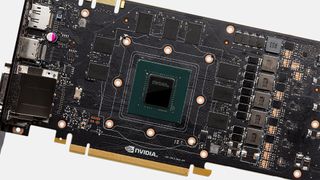
Which is better GTX or RTX?
The older GTX prefix is now used to denote older Nvidia graphics cards which don't have the extra AI and ray tracing silicon that the RTX-level cards do.
This RTX prefix was introduced with the Turing-based RTX 20-series, and highlights which cards have GPUs which sport both the Tensor Cores and RT Cores necessary for real-time ray tracing and Deep Learning Super Sampling (DLSS).
Nowadays you'll only find older 16-series GPUs with the GTX prefix attached, so it's pretty much RTX all the way.
Is ray tracing only for RTX cards?
The RTX prefix is only used to denote cards which house Nvidia GPUs with dedicated ray tracing hardware, but they're not the only ones.
AMD's RDNA 2 GPUs and RDNA 3 GPUs all support real-time ray tracing acceleration, as do Intel's Alchemist graphics cards.
Do note that with more budget offerings, you can't expect high frame rates while it's enabled. Otherwise, AMD and Intel's ray tracing acceleration are pretty good but slower than Nvidia's.
Is SLI or CrossFire still a thing?
If you're looking for maximum performance, you used to run two cards in SLI or CrossFire. However, it's become increasingly common for major games to ignore multi-GPU users completely. That includes all DXR games. There's also the fact that fewer and fewer modern cards actually support the linking of two cards together.
So, no. It's not a thing.
Do I need a 4K capable graphics card?
The obvious answer is: Only if you have a 4K gaming monitor. But there are other things to consider here, such as what kinds of games do you play? If frame rates are absolutely king for you, and you're into ultra-competitive shooters, then you want to be aiming for super high fps figures. And, right now, you're better placed to do that at either 1440p or 1080p resolutions.
That said, the more games that incorporate upscaling technologies, such as DLSS, FSR, and XeSS, the more cards will be capable of making a close approximation of 4K visuals on your 4K monitor, but at higher frame rates.
What's a Founders Edition graphics card?
The Founders Edition cards are simply Nvidia's in-house designs for its graphics cards, as opposed to those designed by its partners. These are usually reference cards, meaning they run at stock clocks.
Briefly, for the RTX 20-series, Nvidia decided to offer Founders Editions with factory overclocks. These had made it a little difficult to compare cards, as Founders Edition cards give us a baseline for performance, but Nvidia has since returned to producing them as a reference again.
Intel also offers something similar with its Limited Edition Arc Alchemist cards featuring its own in-house cooler design, as does AMD with its reference cards.
How much VRAM should a graphics card have?
For basic, entry-level 1080p gaming, the minimum amount of VRAM (video RAM) that any graphics card should have is 4 GB. You'll notice, though, that all of our recommended cards have 8 GB or more, and that's because today's big-budget 3D games have graphics that can eat up more than 6 GB.
Once you're gaming at 1440p or higher, and using high graphics settings, 6GB just won't cut the mustard and even 8 GB might be a bit limiting in some games. This is why the latest mid-range graphics cards, between $350 and $600 in price, sport 12 or 16 GB of VRAM.
The latter is more than enough for almost any game. You'll only need more than this in a small number of games and even then, only under very specific circumstances, such as 4K with maximum settings and frame generation enabled.
If you're using your GPU to do content creation or AI workloads, though, the more VRAM it has, the better the graphics card will be able to handle those tasks.
The biggest gaming news, reviews and hardware deals
Keep up to date with the most important stories and the best deals, as picked by the PC Gamer team.

Jacob earned his first byline writing for his own tech blog. From there, he graduated to professionally breaking things as hardware writer at PCGamesN, and would go on to run the team as hardware editor. He joined PC Gamer's top staff as senior hardware editor before becoming managing editor of the hardware team, and you'll now find him reporting on the latest developments in the technology and gaming industries and testing the newest PC components.
- Chris SzewczykHardware Writer
- Dave JamesEditor-in-Chief, Hardware
